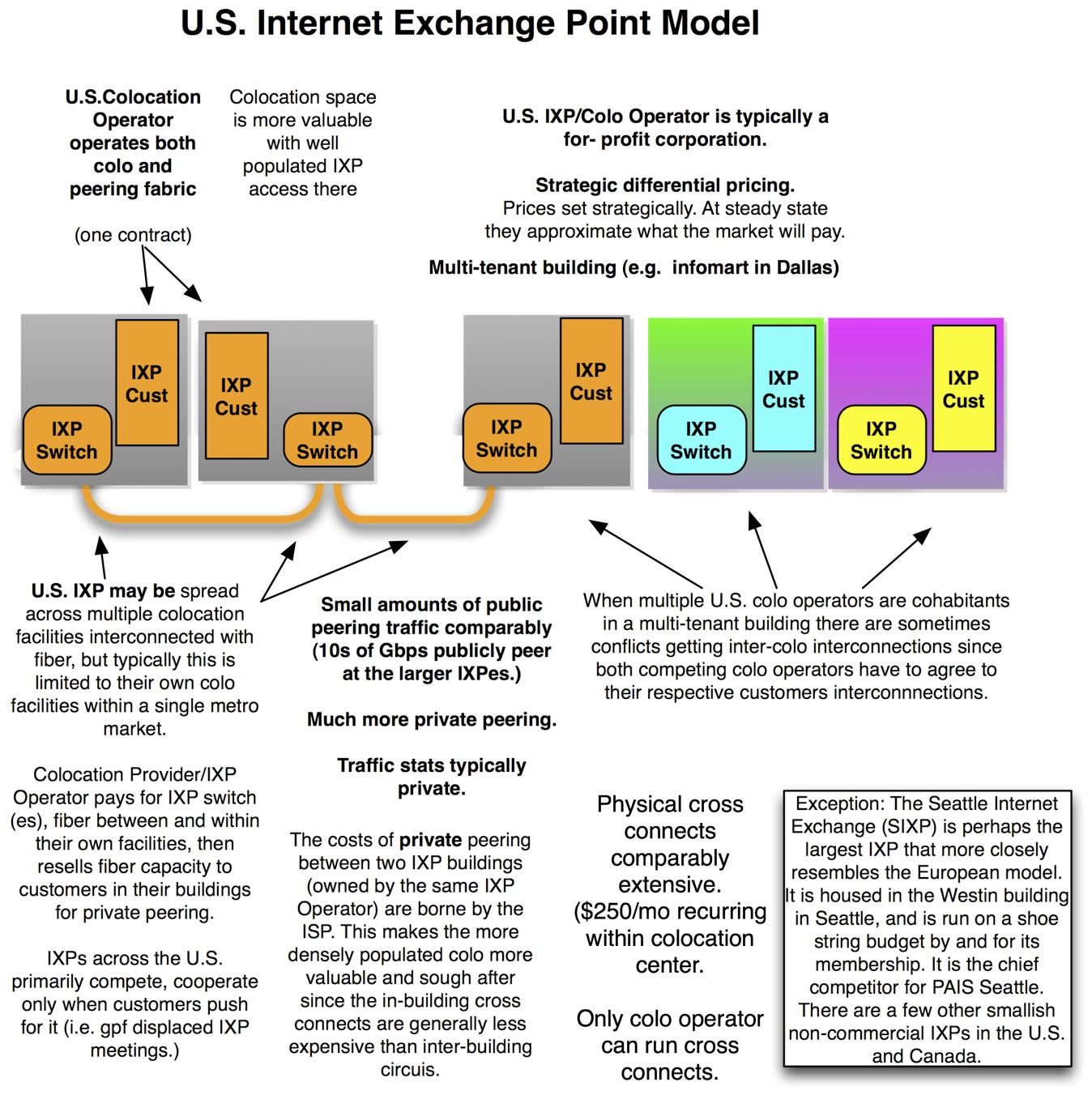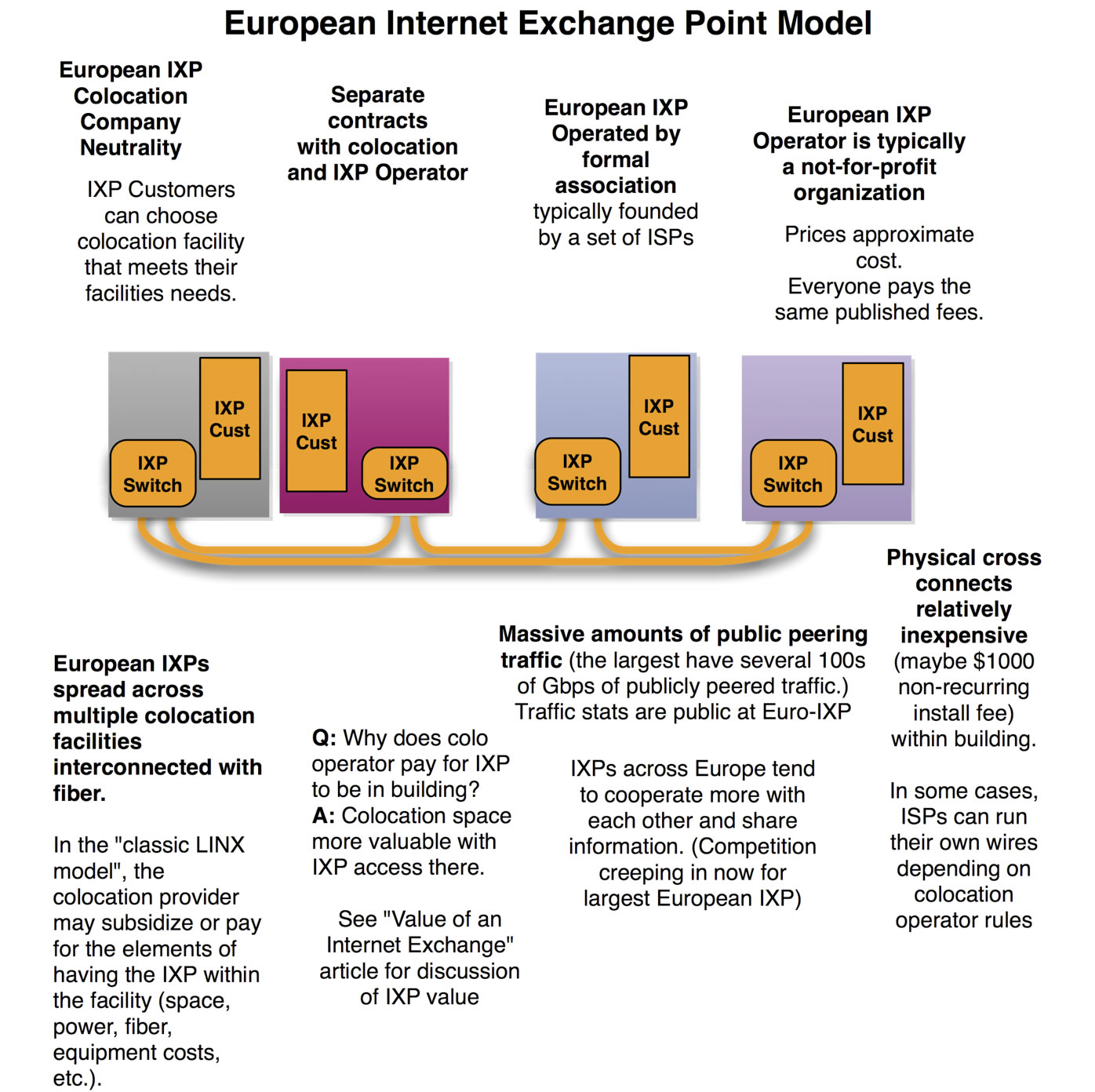What is the difference between U.S. and European Peering?
There are many differences between Internet Peering in the United States and in Europe.
The U.S. Peering Model
The U.S. Peering Model typically involves a commercial (for-profit) colocation center operator that also operates the public peering fabric. The U.S. Internet Exchange Point (IXP) provides and promotes public and private peering within its data center.
Some of the benefits of the U.S. Peering Model are that:
- The colocation operator can set differentiated prices to attract the most valuable peers into the building.
- Colocation and peering prices (both private and public) can be bundled so loses in one can be offset by gains in another. (This is important during the IXP startup phase.)
- Some corporations prefer to deal with other corporations rather than not-for-profit entities.
- There are always colocation/NOC staff on-site to deal with network issues.
- Since a single operator runs all switches and all colocation environments there tends to be greater operations consistency.
- The well-capitalized IXP staff tend to be well compesnated (commercial salary, equity participation) which leads to good staff continuity.
- There is a single contract to sign, and it is a pure commercial transaction; if you can pay, you can play. (There is no "voting" new participants in.)

The downsides of the U.S. peering model include:
- The cost is higher than in Europe for colocation and peering fabrics, primarily since the U.S. pricing model is based on the price the market is willing to bear.
- The commercial operator is not answerable to the collective of peers; it of course wants happy customers, but it is not run by an association and as a collective has little say over policies.
- Highly competitive forces lead to rivalries and very little cooperation and sharing of information.
- Relatively high public peering costs lead to more private peering sessions which provide no transparency.
- Some consider the private peering costs (the cost of a fiber cross connect between two racks) to be too high.
Note that the "U.S. Peering Model" is not limited to the U.S. This commercial IXP model exists in other places as well. For example, Equinix operates this model around the world, as does Telehouse, InterXion, etc.
In a nutshell, U.S. Peering Model IXPs are for-profit commercial endeavors motivated by sustainable profitability.
The European Peering Model
In Europe the exchange points tend to be not-for-profit, peering-community-run organizations, often structured as formal associations of network operators.
(I also call this the "LINX Model" because it originated with Keith Mitchell at the London Internet Exchange (LINX). In the early days, the LINX had used up all of their available space in their colocation facility at Telehouse in the Docklands in the U.K. Since they needed more space, they put out a request for tender and found that colocation companies were willing to pay for the right to house the LINX switch and provide access for their colocation customers. There was a gravitational draw that the colocation companies could leverage, so the cost of the expansion was paid for at least partially by the colocation expansion site. This expansion process continues today with the European Model peering fabrics being spread across multiple colocation facilities. Since then, this LINX model has spread across Europe and to some degree across parts of Asia, so I now refer to this as the European Peering Model.)
At the heart of the European Peering Model is the separation between the colocation operator and the peering fabric operator. These are two different companies. The colocation companies compete to house the peers' network equipment, while providing access to all of the peers available over the peering fabric operated by the not-for-profit association.
All of the other characteristics (benefits and drawbacks) of the European Peering Model are side effects of this separation as shown in the diagram below.

The benefits of the European Peering Model include:
- Everyone pays the same amount; association members do not want to advantage or disadvantage anyone else.
- Members have a vote in the leadership and a say in the policies surrounding the operation of the peering fabrics.
- The IXP often gets free space and power and in some cases cash to buy the switch and fiber extensions into the new colocation facilities
- The colocation company benefits from a lure into their colocation (the switch fabric), and the members benefits from a diversity of colocation vendors with different offerings.
- Private peering is inexpensive; the cross connects in Europe have traditionally been free, or incurring a one-time cost, but seem to be migrating towards the U.S. model of a recurring monthly fee.
- Colocation companies compete in many dimensions including price, leading to lower prices for housing of network equipment.
- Public peering is inexpensive; there are rules preventing not-for-profits from collecting too much revenue, so they respond by lowering the prices which encourages more uptake.
- Public Peering is widely used providing visibility into traffic growth.
The drawbacks of the European Peering Model include:
- Everyone pays the same, which sounds nice, but it ties the hands of startup IXPs when trying to attract the first few people into the IXP.
- There is no guarantee that the colocation operator fills their building up with high-value peers. There have been cases where the building is filled up with a few high paying tenants, providing little value to the peering community.
- The fabric is often deployed across great distances in a metro area presenting a logistical challenge when things break.
- Staff are paid not-for-profit wages with no stock options, while working in a highly competitive commercial industry environment. This has led to turnover, although admittedly surprisingly low turnover given the talent that they employ.
- European IXPs often measure themselves against each other based on public peering traffic volume, while there is substantial private peering traffic as well. Some argue that public peering is not sustainable at the volumes expected over the upcoming years, so some more conservative IXPs have migrated to the hybrid private/public peering systems. These IXPs are unfairly penalized in the comparisons of public peering traffic volumes.
- Colocation companies are relegated to providing low-value commodity colocation with little stickiness, which makes it difficult to justify further colocation builds.
In a nutshell, European peering is a cooperative membership-driven peering operation, with an explicit desire to be sustainable but not profitable.
European IXPs typically limit operations to their own countries, but this is now changing.
European IXPs tend to cooperate with other European IXPs, but this too has been changing as competition between them creeps in.

